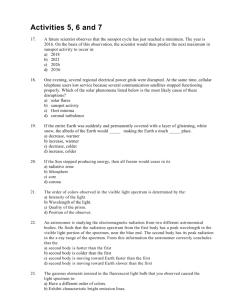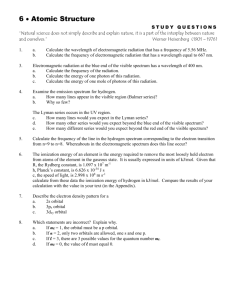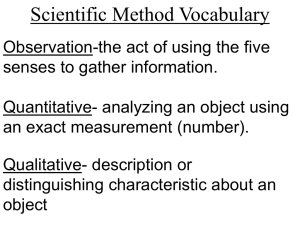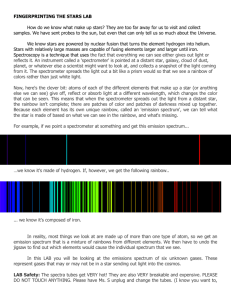Expansion of the Universe
advertisement
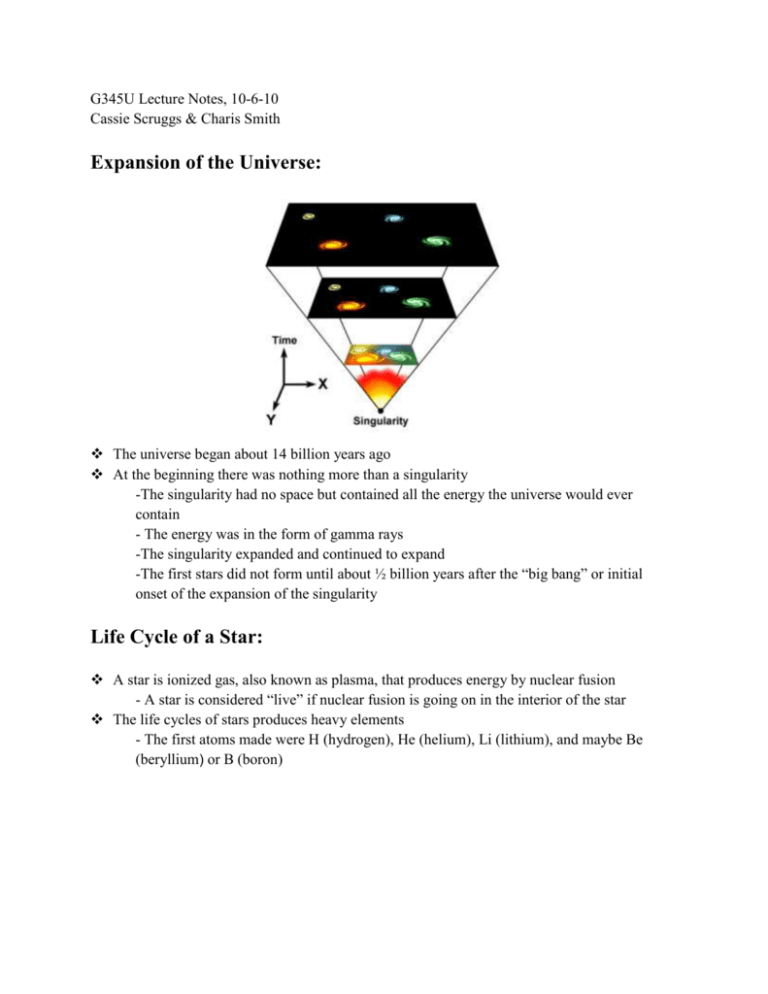
G345U Lecture Notes, 10-6-10 Cassie Scruggs & Charis Smith Expansion of the Universe: The universe began about 14 billion years ago At the beginning there was nothing more than a singularity -The singularity had no space but contained all the energy the universe would ever contain - The energy was in the form of gamma rays -The singularity expanded and continued to expand -The first stars did not form until about ½ billion years after the “big bang” or initial onset of the expansion of the singularity Life Cycle of a Star: A star is ionized gas, also known as plasma, that produces energy by nuclear fusion - A star is considered “live” if nuclear fusion is going on in the interior of the star The life cycles of stars produces heavy elements - The first atoms made were H (hydrogen), He (helium), Li (lithium), and maybe Be (beryllium) or B (boron) Temperature Scales: Absolute Zero Freezing Point Boiling Point of H2O Kelvin 0 273 373 Celsius -273 0 100 Fahrenheit -460 32 212 There is a larger difference between scales at smaller temperatures and not much of a difference between scales at larger temperatures. -Kelvin and Celsius are approximately equal at large temperatures -Fahrenheit is approximately double Kelvin and Celsius at large temperatures When referring to the temperature of a star, we are using the photospheric temperature The photosphere is the first visible outer layer of a star o 300-500km thick and 4000-8000Kelvin Fraunhofer lines determine the chemical composition of the photosphere. o Darker lines determine the concentration of the element http://astro1.panet.utole do.edu/~ndm/ASTR4810/g0fraun.jpg Waves: Waves transmit energy - The height of the wave is the amplitude - The length of the wave from crest to crest is the wave length - The number of cycles/sec is the frequency Light Spectrum: Light is an oscillating electric and magnetic field also called and electromagnetic radiation Light is the only energy source that can transmit through a vacuum -It is self perpetuating because a disturbance in an electric field causes a magnetic field and a disturbance in a magnetic field causes an electric field -Visible light is in the 400-700nm range Visible light is in the 400-700nm range The shorter the wave length, the more energy is being produced Opaque objects emit electromagnetic according to temperature radiation o Hot = deep red o Hotter = red to orange o Hotter Still = yellow to white http://www.countryliving.com/cm/countryliving/images/CLX0305Guild007-de.jpg Blackbody Emission – “In physics, a black body is an idealized object that absorbs all electromagnetic radiation falling on it. Blackbodies absorb and incandescently re-emit radiation in a characteristic, continuous spectrum.” http://en.wikipedia.org/wiki/Black_body http://astronomy.swin.edu.au/cms/imagedb/albums/userpics/blackbody_radn_curves.png Dilute Gases: Each chemical element produces its own unique set of spectral lines at specific intervals Gases can ABSORB parts of light, and REEMIT at a later time Emission Line Spectrum – “The emission spectrum of a chemical element or chemical compound is the spectrum of frequencies of electromagnetic radiation emitted by the element's atoms or the compound's molecules when they are returned to a lower energy state.” http://en.wikipedia.org/wiki/Emission_spectrum http://www.astro.bas.bg/~petrov/herter00_files/lec07_04.jpg Spectral lines are produced when an electron jumps from one energy level to another within an atom o There are specific orbits an electron can exist on o To become “excited” an electron needs to absorb wavelengths http://www.freewebs.com/mdreyes3/electron_1.jpg Hydrogen spectral lines are the most important when studying stars because stars are composed mostly of hydrogen

